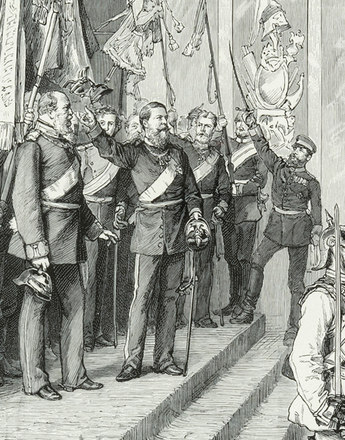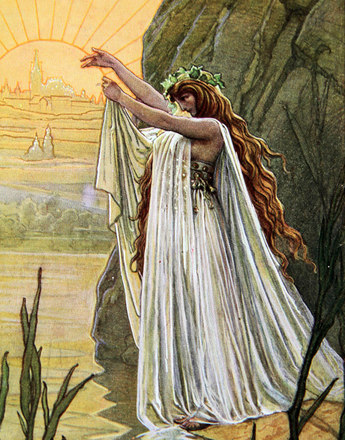The radical German nationalists and their attitude to the Habsburg Monarchy
From the unification of 1871 onwards, more and more German-Austrians came to see Germany as their ‘true homeland’. A widespread veneration for Bismarck developed, which was only partially tolerated by the Austrian authorities, being regarded as an expression of German irredentism and of a longing to be ‘nationally redeemed’ through unification with the German Reich.
Die Wacht am Rhein
Es braust ein Ruf wie Donnerhall,
Wie Schwertgeklirr und Wogenprall:
Zum Rhein, zum Rhein, zum deutschen Rhein!
Wer will des Stromes Hüter sein?
Lieb’ Vaterland, magst ruhig sein,
Fest steht und treu die Wacht am Rhein!
The Watch at the Rhine
The cry resounds like thunder’s peal,
Like crashing waves and clang of steel:
To the Rhine, the Rhine, our German Rhine,
Who will defend our stream divine?
Dear fatherland, no fear be thine,
Firm and true the Watch at the Rhine!
The ‘Wacht am Rhein’ is regarded as having been the battle-hymn of German nationalism. The text is a poem of 1840 by Max Schneckenburger, which was set to music by Carl Wilhelm in 1854.
For many people Germany seemed to be a model country in comparison with an Austria incapacitated by conflicts between the nationalities. In the German Reich an increasingly aggressive vein of German nationalism – fired by the myth of its foundation in 1871 ‘through iron and blood’ in the confrontation with France – was accompanied by rapid economic expansion. Now developing into Europe’s leading industrial power, Germany was the epitome of vigour and growth.
Amongst the German-speakers in Austria this naturally led to a change of general attitude to the Habsburg Monarchy. The old-established German Liberals, whose brand of German national consciousness had been marked by loyalty to Austria and a great sense of responsibility for the state as a whole, were now superseded by a younger generation of German nationalists with quite a different outlook.
The demands of the German nationalist camp now became more radical, with the highest priority being given to the purely nationalist agenda. Among other things, this meant the end of the idea of a centralized state, which had been upheld principally by the German Liberals and was now rejected by the political representatives of all the nationalist movements as an obstacle to their national development.
The ultimate goal of German nationalist agitation was the secession of the German-speaking areas and their incorporation into the German Reich, even if this meant the downfall of the Habsburg Monarchy. In this sense they followed the ideal of Pan-Germanism, that is to say, they called for the bringing together of all Germans into one state, which posed an incalculable threat to the traditional Central European system of states.
From the 1880s onwards the extreme right wing of the German nationalist movement developed a markedly ‘Volk’-based philosophy that postulated the intrinsic superiority of the ‘German race’. This tendency was particularly radical in Austria, where many people were frustrated at having been cut off from the ‘German Fatherland’ through the implementation of the ‘smaller-German solution’. In addition, it was a reaction to the success that the Hungarians and Slavs had had in liberating themselves from German domination. The movement was joined by an astoundingly large number of former Liberals and intellectuals, with the universities playing a notorious role that should not be forgotten.
The leader of the radical wing of the German nationalists in the Habsburg Monarchy was the out-and-out demagogue Georg von Schönerer (1842–1921). He was not only anti-clerical and anti-Slav but also highly anti-Semitic, which set him apart from the old-established form of German Liberalism that had been the classic political home of the prosperous class of assimilated bourgeois Jews. Schönerer’s political ‘style’ did not go any further than rabidly inflammatory speeches and polemicizing in and for the media; nor did he shy away from publicly condoning the use of violent means.
Translation: Peter John Nicholson
Hanisch, Ernst: Der lange Schatten des Staates. Österreichische Gesellschaftsgeschichte im 20. Jahrhundert [Österreichische Geschichte 1890–1990, hrsg. von Herwig Wolfram], Wien 2005
Kann, Robert A.: Zur Problematik der Nationalitätenfrage in der Habsburgermonarchie 1848–1918, in: Wandruszka, Adam/Urbanitsch, Peter (Hrsg.): Die Habsburgermonarchie 1848–1918, Band III: Die Völker des Reiches, Wien 1980, Teilband 2, 1304–1338
Rumpler, Helmut: Eine Chance für Mitteleuropa. Bürgerliche Emanzipation und Staatsverfall in der Habsburgermonarchie [Österreichische Geschichte 1804–1914, hrsg. von Herwig Wolfram], Wien 2005
Sutter, Berthold: Die Deutschen, in: Wandruszka, Adam/Urbanitsch, Peter (Hrsg.): Die Habsburgermonarchie 1848–1918, Band III: Die Völker des Reiches, Wien 1980, Teilband 1, 154–339
-
Chapters
- The German-Austrians in the Habsburg Monarchy
- German Austrians or Austrian Germans?
- Holding the Monarchy together: The German-Austrians as the guarantors of Habsburg statehood
- In search of the Fatherland: The genesis of the German nation
- To join or not to join? Austria and the process of German unification
- Fear of losing hegemony: The German-Austrians in the Austrian multi-national state
- The radical German nationalists and their attitude to the Habsburg Monarchy
- The concept of ‘German Central Europe’
-
Chapters
- The drive for unification
- The radical German nationalists and their attitude to the Habsburg Monarchy
- The concept of ‘German Central Europe’
- Together we are strong: Pan-slavism and "Slavdom"
- The rise and fall of Austro-Slavism
- "Two branches of one nation" – Czechoslovakism as a political programme
- Viva l’Italia! Italian irredentism and the Habsburg Monarchy
- From Illyrism to Yugoslavism: competing concepts for a southern Slav nation
- Élyen a Magyar – long live the Magyars! Hungarian Magyarization policy







